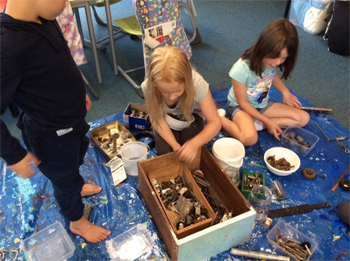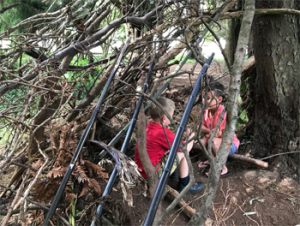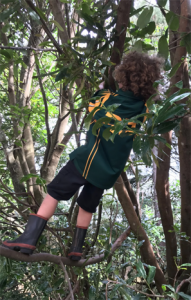Kaimai School, a small rural full primary, is part of a network of 11 schools in the greater Tauranga area working together to investigate how play can be used to enhance learning.
Kaimai principal Dane Robertson shares his findings about play-based learning and Kaimai School’s journey so far to put this into action.
Photo: George Novak
Where did your interest in play-based learning come from?
I read an article in the Guardian that outlined how schools in Colorado reduced schooling to four days a week due to a funding crisis. This resulted in improved achievement and one reason given was that this enabled children to be more involved in extracurricular activities of their own choosing on the fifth day. Less school led to better results and I wanted to investigate this further.
My wife is a kindergarten teacher so we often discussed why children come into a different learning environment when they transition to school. This led me to become interested again in Piaget’s Cognitive Stages during sabbatical.
What are you doing at Kaimai School to implement play-based learning?
In 2017 the staff had professional development with the Brainwave Trust and Nathan Mikaere-Wallis which focused on neuroscience and how the brain works. Following that our junior teacher attended a Pennie Brownlee professional development day and all staff attended two Longworth Education workshops.
Our junior classes still have the focus of reading, writing, and maths, but the follow up activities have often been replaced with free play. The teacher will put out "invitations" or "provocations". These are open-ended "starting points" for play. Ideally, these will be based on meeting the students' play urges and interests. The items set up, ideally, should be natural materials. This helps link students to nature and also helps develop their imagination. An example being that a plastic apple in a play kitchen will only be played with as an apple; whilst a pine cone could be an apple, or an egg, or salt shaker, or bottle of tomato sauce, etc.
The teachers are now focusing on the quality of the formal learning time, rather than quantity. The teachers are finding that the students are more engaged in their reading and maths groups and the discussions are much deeper.
The staff began to develop a review in regards to where they are at. They modified Kaplan and Norton’s Balanced Scorecard to try and address any areas of need in the areas of teaching and learning, stakeholders, internal systems and processors, and learning and growth. What was interesting about this approach was that it helped to keep the focus on the learning. They created a plan that uses progressions and expected curriculum levels as key measures of whether our approach is working.
Currently, teachers are trialling:
- Taking more time with each group by using provocations of play, for example, setting up a potions table so children can mix their own potions; and putting blankets and sheets outside for making huts.
- Using play to develop social skills. For example, an autistic student wanted to join a group in their hut inside the classroom. He was told by the other students to wait and then given a role to choose from. It was a big thing for him to wait and then select a role, something that he would usually find very difficult. He was following the provocation set for him by his peers.
- Extending the play. For example, using a provocation “I wonder if animals could talk, what would they say?” This came from an activity the children had set up themselves, making animal noises, so the teacher extended this. The more experiences students have the better their reading comprehension will be.
What is your school wide approach?
The school wide approach is to look at the whole student. We fell down the “rabbit hole” of focusing on students who were struggling in reading, writing, and maths. Late last year we realised we had not looked carefully at the whole student, as we had students who in the areas of reading, writing, and maths were at, or mostly beyond, their expected levels but had huge social gaps.
We still look at the student's academic progress but we also consider where they are in regards to cognitive stages, Parten’s Stages of Play, play urges, etc. We are finding that some of our students have behaviour issues well behind their peers when it comes to play. Play is an easy way for teachers to observe the key competencies in real situations, which are student led and student focused.
We are beginning to investigate what play-based learning (PBL) looks like in the middle and senior classes. Students participate in "Do It Yourself" (DIY), the name for our inquiry projects. We are now more focused on the process, rather than the product. We are treating inquiry time more like play and use Peter Gray’s definition:
"Play by definition, is, first and foremost, an activity that is self-chosen and self-directed. It is an activity that you are always free to quit. Activities that are chosen by teachers and directed or evaluated by teachers, is not play."
Peter Gray
When we first introduced this, students gravitated towards their friend’s projects. It took about a term for the students to start working in areas they were interested in. This formed new friendships and the sharing of ideas in an authentic, student driven way.
Play-based learning and the NZC
Learning through play at Kaimai School is helping the school realise its own vision of "positive learners" as well as The New Zealand Curriculum vision of confident, connected, actively involved life long learners. Teachers are supporting students to develop values, key competencies, and understandings across all learning areas.
How does Kaimai School ensure that literacy and numeracy skills and knowledge are developed through play?
Research says the more experiences a child is exposed to the better their reading comprehension will be. Unfortunately, there are children who live in New Zealand, even in Tauranga, that have never been to the beach. How can a child truly comprehend text about the beach if they have never experienced it? Especially if the child is still in the concrete operational stage of development. They need experiences that can be used to attach new, and sometimes more abstract, concepts.
Nathan Mikaere-Wallis has said on numerous occasions that there is no research anywhere that shows teaching a five-year-old like a seven-year-old will be beneficial. The concept of children learning in a "typical western school setting", from a human evolutionary point of view, is very new when looking at the human evolutionary process. Science has shown that depriving animals of play in their adolescence results in major social complications as adults. Thus the researchers suggest that humans are no different and that play is a vital part of human development.
At Kaimai we still support the teaching of reading, writing, and maths. It is not an "either or" approach to schooling.
What changes have you made to the physical environment of the school?
We have put in a skate park. This was a $130,000 project that took a lot of fundraising to achieve. The park has only been in one term so far, but we are beginning to see students develop confidence, patience, perseverance, calculated risk taking, and resilience. All these personality traits are hugely important in adulthood, and the only way this can be achieved is to offer these experiences for children in a controlled environment.
We also allow students to play bullrush, climb trees, make huts, etc. A lot of schools are doing this and they are important for children to experience. The last thing I would want is for one of our students to experience their first risks at the age of 18.
We want to now develop our native area more. The first plan is build a storage area, in the form of a wooden barn, to store tyres, scaffolding planks, wooden climbing boxes, etc. We are also looking at developing a mud kitchen area and a fire pit. Of course, this all takes time and some money, but we will get there.
Can you describe a PBL classroom?
You would expect to see and hear children playing some of the time, other times, it looks like a typical classroom. It can look messy and it is noisier. There are also disagreements at times, and we have decided to offer help only when the children are stuck, or if the problem is out of hand. How can we develop problem solving adults, if we solve all their problems for them?
What have you discovered so far? Has it enhanced learning overall?
I have discovered that I still battle with what I know the research says versus what "normal" schooling should be. We have only begun trialling PBL in earnest this year so it is still too early to assess if we are accelerating learning, but we should know by the end of term 2.
What have teachers discovered so far?
“The children get along a lot better. This was noticed by the student teacher too when she commented that the students play so well together. The students are beginning to solve their own problems now and there are fewer students coming to me with the small issues – they are self policing their own behaviour. They are more engaged in their reading, writing, and maths groups. They are wanting to come to work with me and they are more focused when we are working as a group. I am finding I can do more with my year two students this year too; they are more confident to give things a go. Some students are even initiating further learning at home. I am seeing more confident students, who are willing to take more risks."
Sarah McMechan (New Entrant to Year 2 teacher)
How have you involved parents in PBL?
We held a free Brainwave Trust evening for parents at the beginning of last year and encouraged all our parents to attend Nathan Mikaere-Wallis’ workshops when he spoke in Tauranga.
I also shared my sabbatical findings in our community newsletters. I have been sharing articles on our school facebook site and meeting and talking to parents. I try to keep the information coming for parents, but keep it in small, readable chunks.
The staff and I ran a parent-teacher information evening mid term 1 of this year, and covered some neuroscience, cognitive development, research (both historical and current), as well as going over what a typical day looks like in each classroom.
What has been the feedback from parents so far?
Some parents absolutely love it, while others are still a little unsure. The comments I have received from two families that have been at our school for a short time is that their child is a lot more confident, is happier at school, and now loves coming to school. They also acknowledge that their learning (the three Rs) has not suffered at all and in one case, improved faster than any other time. But, they are still worried their child is not doing enough sitting at a desk and "doing" school work.
What do students say about play-based learning?
“DIY is good because we are learning through play and letting our imagination run wild. It helps me because it gets me to think and I like to explore my ideas. When I work with others we share our ideas and it gets my brain working even more. I think I am getting better at maths because I am learning new techniques to figure out math problems.”
Katie (Year 6)
“It is a good chance to learn new stuff. On the skate park we wanted to learn new tricks and we practice, we started small and slowly got better. We filmed our tricks, then we looked at what we did right and what we did wrong, then we tried to improve on that. I like how we can choose what we want to do and how we can improve.”
Will (Year 5)
“We are making a hut. Our plans are to make a new roof for our hut and we want to make wood walls too. We need to make a swing for it, so we are going to use a chain to make a safe swing. We are also going to make some protective walls for the plants that are around our hut so that the plants can keep growing. I have been thinking that I might need to dig some holes to put poles into them, this will make the walls stronger I think. I like playing because you get to build and learn new stuff, like that if I give up, it is not a good choice, you keep on working and it might get better.”
Max (Year 3)
“I like play, we get extra time to play. We like playing with the lego that we have. We make animals with the lego and we start to play with it and then we break it up again to make something new. School is very different here, I think it is easier to learn here than when I was in England. I am learning way more here than in England too.”
Sammy (Year 3)
“It is fun to play, because you get to play and learn at the same time. I mainly go on the back playground or make huts. We play squirrels in our huts. We don’t really have any arguments, we just play. I think I am better at my reading now from last year, my reading level has gone up.”
Leila (Year 2
What advice would you give other educators who want to implement play-based learning?
- Start slowly and in bite sized chunks.
- Take time for staff to understand the science and research.
- Give families plenty of information early and often.
- Increase your storage area!
What are your future steps?
We are in the beginning phases of this education "journey" and we still have a long way to go. There are a number of approaches that the teachers can take – looking at play urges, types of play, and developmental stages. The teachers have to pick one area and focus on that, or it can become overwhelming. There will be a lot more focus on what teachers are putting out to reinforce the learning and how this links from their reading to the provocation.
How can teachers make play-based learning more explicit but not so that it is teacher-driven?
Term 2 will see the teachers having to think carefully about the provocations that they offer their students, and try and develop play opportunities that will scaffold the learning the teacher is aiming for. We’ll be looking at results. Are we seeing the progress we expect?
You might like ...
Beginning a journey into play
Leslee Allen, principal of Kaurihohore School, is an advocate and practitioner of play-based learning. In this blog, Leslee shares key considerations for teachers who are interested in beginning a journey into play.
- Tags:
- effective pedagogy
- primary
Return to top






